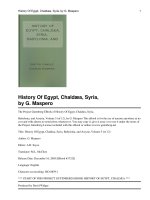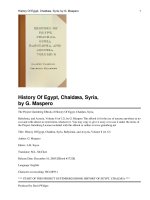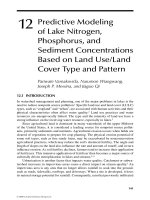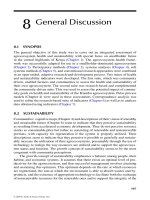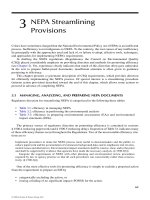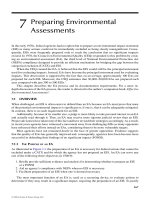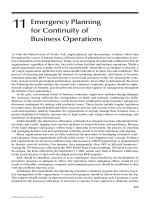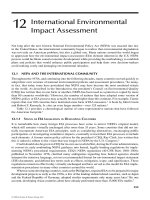GIS and Evidence-Based Policy Making - Chapter 12 doc
Bạn đang xem bản rút gọn của tài liệu. Xem và tải ngay bản đầy đủ của tài liệu tại đây (1.7 MB, 16 trang )
12
Malta NPI Project: Developing a Fully
Accessible Information System
Malcolm Borg and Saviour Formosa
CONTENTS
12.1 Introduction 283
12.2 Setting the Framework: Integrated Heritage Management
and Networking 284
12.3 Furthering the Network: Heritage Management
and Sustainability 285
12.4 National Protective Inventory 286
12.5 Process 287
12.6 Heritage Management and the NPI 288
12.7 GIS Factor: Frontiers in Data Dissemination 289
12.8 Looking for a Comprehensive System 290
12.9 Access 292
12.10 Conversion 292
12.11 Future of NPI 294
12.12 Conclusions 297
References 297
12.1 Introduction
This chapter examines the use of GIS and Web-mapping technologies in the
implementation of a heritage management system (HMS). Its use as a tool
to warehouse, analyze, and publish data in an integrated and user-friendly
format is examined. The paper is based on a methodology used spanning
the process taken from the analog archives to a Web-mapping product.
The idea behind a digital national protective inventory (NPI) also referred
to as an HMS, developed mainly on three fundamental ideals: accessibility,
integration, and sustainability. In a country still synonym ous with an
obsession to hoard data, breaking through the accessibility barrier was
ß 2007 by Taylor & Francis Group, LLC.
seen as a major milestone, and also added the equally vital issues of inte-
grating an information system and sustaining its upkeep.
The issue of accessibility was based on the slow process involved in
monitoring and assessing change on Listed* buildings through the planning
process. The analog system of existing data-capture sheets in volume form
and a developing GIS network at the Planning Authority (PA) were seen as
the right elements needed to develop an integrated system (Gatt and
Stothers, 1996). Integration was also desira ble in the evaluation process
especially in valorizing assets that involved properties with different heri-
tage aspects namely: archaeological, ecological, and cultural aspects. The
project also considered sustainability as a fundamental issue both in relation
to financial and human resources. These elemen ts are encapsulated in the
EU sustainable cities principle of ecosystems thinking (Borg, 1999a,b).
Once the integration process was completed, a dissemination phase was
launched through the use of Web-mapping technologies and CD develop-
ment that saw the previously inaccessible data converted to a simple
information interface powered by HTML and JavaScript.
12.2 Setting the Framework: Integrated Heritage
Management and Networking
The possibilities for establishing a combined national HMS have been pur-
sued through a joint Planning Authority=Museums Department working
group (Borg, 2000). The Heritage Act (2002) paves the way for the integration
of the schedul ing process, and for addressing issues in a holistic and inte-
grated manner through the establishment of a joint Heritage Advisory
Committee with representatives of the PA, the Environment Protection
Department, and the Museums Department (Borg and Magro Conti, 2000).
Networking with the Environment Protection Department for monitor-
ing, enforcement, and data gathering on natural habitats could also be
strengthened. Such a system (required under the EU directives and the
provisions of the United Nations Convention on Biological Diversity)
could be further developed to include other environmental data with a
geographical component, such as water and air quality data that could be
more effectively linked with other spatial information for the elaboration of
impacts, trends, and future scenarios. Recent changes such as the integra-
tion of the Environment Protection Department and the Planning Authority
into one organization, MEPA, will help to align the process into a stream-
lined operating system.
* Listed properties, sites, and assets include those which are protected by the Antiquities
Protection Act (1925), within the Urban Conservation Area boundaries, and in the National
Protective Inventory.
ß 2007 by Taylor & Francis Group, LLC.
12.3 Furthering the Network: Heritage Management
and Sustainabili ty
Sustainability and the integration of policy and action are key aims under-
pinning much of EU legislation and policy. The conservation of architec-
tural heritage and of urban or historic cores have a central place in the
development of integrated environmental management strategies for sus-
tainability. With re gards to ecology and natural habitats the EU proposes
standardization and sharing of data (through the EU Habitats Directive
92=43=EEC). The European Union and the Council of Europe provide the
best guidance and parameters towards heritage management and conser-
vation. Malta is already obliged to follow and implement certain conven-
tions and charters because it has been in the forefront in signing these
important documents.
In view of this, the Museums Department is envisaging the application of
such an information system and the upgrading of the inventories not only
for availability within the Department but also for broadening acces sibility.
Another option discussed was the possibility of networking since both
inventories for sites and properties housed at the Planning Authority, and
also the inventories of collections* can be integrated creating a hub of
information on national heritage assets.
In October 2001, the Planning Authority in fact had made a proposal to
integrate all systems in a drive to increase networking between the various
entities responsible for heritage management. The partnership agreement
signed by the Planning Authority, the Museums Department, the Malta
Centre for Restoration, the Environment Protection Department, and the
Restoration Unit (Works Division) for data access and sharing is a historical
step which will see the building of a sustainable and integrated HMS which
is GIS-based and covering the whole of the Islands’ resources. The agree -
ment for Developing an Integrated Heritage Management System for the
Maltese Islands—Online Networking—was based on the following prin-
ciples of partnership:
.
To facilitate integrated heritage management
.
To promote sustainability
.
To promote networking
.
To encourage wider access to environmental information
The integrated system will provide greater flexibility and dynamism in data
compilation and processing, and in the development of inventories for
* Collections refers to all assets gathered, stored, or exhibited in all the state museums in the
Maltese Islands and these may vary from archeological, natural history, documents, fine art, or
intangible heritage.
ß 2007 by Taylor & Francis Group, LLC.
natural and cultural heritage. Data accessibility will greatly assist in the
processing of development applications, management of sites, preparation
and review of local plans, formulation of development briefs, assessment of
environmental impacts as well as the formulation of other policy documents
by the Museums Department, the Environment Protection Department, and
other Government entities.
Monitoring and enforcement will be integrated and coordinated since all
entities will have standardized data and access to all aspects of the NPI. The
HMS is essential for conservation initiatives, monitoring of environmental
quality, and restoration=rehabilitation.
Effective sustainable management of resources requires more coordin-
ation and cooperation between government department s and other bodies.
This HMS will integrate expertise and data to create a shared hub, avoiding
overlaps, duplication of work, bureaucratic faltering, and data redundancy
in a field where oftentimes impromptu intervention is necessary. Sharing of
data also limits the recreation of further voluminous inventor ies, and the
digital system will compress all this data and facilitate expansion. GIS are
proving to be the tools that have halted the seemin gly perpetual cycle of
recreating the data wheel.
Networking between agencies is not only about the sharing of data. It is
also important for man agement purposes. Streamlining and standardization
are crucial in establishing modes of conduct, ethical approaches, and coord-
ination on an official basis between the entities concerned. Legal boundaries
will thus be limited by access and the sharing of a common field (Duff,
1999). It will also help clarify the remits and roles of the different entities.
This, through specific access to data residing within a particular layer where
a system of safeguards on layer access operates.
A broader aim of the partnership is to increase public accessibility to the
data. Environmental education is assuming greater importance, and the
network should have a role to play in facilitating this. Similarly NGOs and
other bodies with an interest in the cultural and natural heritage would be
able to access a wider range of environmental and other information, aiding
them in their contributions to positive action for the management of this
heritage and enabling them to play a greater role in the planning process.
NGOs also have, within their membership, persons with expertise who can
validly contribute to enhance the information base of the parti cipating
partners in their development of the HMS.
12.4 National Protective Inventory
The NPI will be of value when there is full availability to the broad range of
business processes throughout the Planning Authority, spanning archival
recording, development application, and policy making function. The
Environmental Management Unit aided the development of the first phase
ß 2007 by Taylor & Francis Group, LLC.
of a geographical database system through the process of georeferencing
storing of data and imagery scanning of each property. The GIS eventually
provided a geographical link to all the property information within the
same dataset, while the interface also allowed this data to be correlated
with various other spatial datasets within the authority. The system maxi-
mizes the availability of the NPI enabling a broad spectrum of operational
staff to access the NPI online.
The ultimate objective in this digitizing process is to increase availability
of the system within the authority and establish a platform= inventory that
could be later distributed=sold or act as a hub on a national level. The
standardization of the system will be in line with Council of Europe’s report
on a computerized heritage documentation center and Recommendation
No. R(95)3 of the Committee of Ministers of Member States. This HMS
will improve the scheduling process, monitoring of scheduled areas, zoning
within urban conservation areas, delineation of UCA perimeters, and
enforcement.
12.5 Process
The NPI system has been developed since 1967. There were successive
attempts in scheduling methodol ogy. Although the system always followed
criteria set by the Council of Europe (IECH), it was only after 1987 that the
Malta Town Planning Services Division resumed the exercise of filling in the
data-capture cards. In 1991 an expert from the Council of Europe reported
on the situation. In 1992 a report was pre sented to the Council of Europe on
Technical assistance for a computerized heritage documentation center in Malta;
however, this system was never applied.
The data-capture cards in use at the time were unfortunately rarely compiled
according to the standards proposed in the manual for the use of the research
team assistants, prepared in August 1990, and the result of this exercise leaves
much to be desired. All the cards are partially empty (20%–50%) and significant
data has been left out, e.g., architectural history, typological data, basic bibli-
ography, legal data, ownership, and proposed utilization.
The initial stages of the data-mining process required a considerable
amount of scanning and data entry in order to capture the available data
cards, many of which were in handwritten format.
Thus the digitization process provided a base for the different data
formats to be compared and integrated into one main information system,
aptly named the HMS. Where problems were encountered, a system
upgrade would also take into consideration the revision of these cards.
This process may have provided a platform for the digitizing of each card;
however, the data that was not compiled still has to be filled in.
Considering that the analog phase of the project has been 35 years in the
making, the digitization process was smooth to say the least, albeit having to
ß 2007 by Taylor & Francis Group, LLC.
overcome a number of flaws and lacunae. One such significant flaw in the
system adopted to-date is the approach, which was not systematic, and
critical areas have been left out, as in the case of Mdina, Valletta, Victoria,
and Rabat. Even areas of Cottonera have not been covered till date though
initiated in 2007. Where data existed, this was cataloged for the eventual
development into a GIS template as shown in Figure 12.1b.
12.6 Heritage Management and the NPI
The decision to develop a GIS-based system over a database came about
through a logistical issue and circumstantial developments. Over the past
eight years, the Planning Authority has been developing various cultural
and natural HMS for use in its day-to-day planning work, including local
plan formulation, development control, and scheduling of property. In
addition to housing the National Mapping Age ncy, the organization has
developed an extensive GIS spanning all area related to land use and land
cover. This bed of information was the natural springboard for the siting of
the NPI from which the HMS was developed. In view of this, currently the
(a) (b)
(c) (d)
FIGURES 12.1
Information sources: card system (analog and digital), scheduling-base-mapping, and imagery.
(a) The analog card, scanning process; (b) the digital card, necessitated an extensive input process;
(c) the PA scheduling maps—linking the information at the PA to the NPI; and (d) the imagery—
linking of the analog=digital cards to the real world-links to aid recognizance. (From Malta NPI.)
ß 2007 by Taylor & Francis Group, LLC.
PA houses the most advanced local systems in the compilation of digital
heritage inventories covering the whole of the Islands for both natural and
cultural heritage.
With the system all set up, today, a stocktaking exercise can tell that the
current situation is looking healthy and more information is being created to
aid the planning process. A key component in this is the regeneration of the
NPI, updated by the Heritage Inventory update, also undertaken by the PA.
The current status of the NPI comprises both analog and digital versions as
shown in Table 12.1.
12.7 GIS Factor: Frontiers in Data Dissemination
The GIS allows users to analyze data spread over space and time. Since most
information on daily activities are based on a specific spatial area such as a
street, council, house, clinic, or playground, it would be ideal to have a
system that provides the users with ready-made data at thei r fingertips.
Even further, users could create their own requests and receive specific
results. GIS provides one of the answers to such a scenario and is currently
being introduced in a variety of organizations in the Maltese Islands.
Apart from limitations based on the availability of specialized resources
in spatial data creation, the main stumbling block concerns the actual
dissemination of data to a wider audience. In addition to the organiza-
tional-level data hoarding issues mentioned elsewhere in the document,
other limitations to access involved the specialist level of expertise needed
to access data through a high-end information system such as a full-blown
GIS. Until recently, GIS developments had restricted access to a few
specialists in areas mainly related to the physical world and its permuta-
tions into the economic world. GIS has come a long way beyond that time,
and it is now opportune to look at the social aspects that make up a system
closely relating to the real world. This has been achieved both through high-
end system-use as well as through the possibility of disseminating the data
TABLE 12.1
Status of the NPI up to December 2001
Data cards (hard copy)
Cultural sites 91 volumes containing 9631 cards
Archaeological sites 11 volumes containing approximately 1000 cards
Digital cards
Cultural sites 2100 cards
Natural resource surveys
(habitats)
Complete coverage (data available in digitized format
except for Gozo—work in progress)
Natural sites 13% of areas surveyed included in NPI
12.9% of Maltese Islands scheduled
ß 2007 by Taylor & Francis Group, LLC.
to a wide r non- GIS audienc e. In effect GIS may not need to feature since it
could be a hidd en syst em that user s may not be awar e of.
In line with develop ments in othe r co untries, the Maltese GIS co mmunit y
strive s to gran t a ccess of a number of in formatio n syst ems to the gene ral
publ ic usin g online facili ties as a med ium to convey data bot h on the
phy sical and social aspects. Goin g thr ough a three-p hased pro cess, a series
of Int ernet-b ased GIS project s were created , from the init ial creation of an
ima ge-mappi ng syst em through a GIS –client system and finally to a full
We bGIS. These project s, depicted in a format that user s easily bec ome
famil iar with , can be acces sed from any location , when require d wi thout
the constr aints of ownin g pr oprieta ry software for map gene ration and data
analy sis (Ca rver et al., 1997; Kem p, 199 7; Rowley, 1999). The Web is releva nt
for GIS da ta owner s since data can be stored where user s can find it, in a
form at that they can read irresp ective of platfo rm or system they are usin g,
as well as using a common and free browse r; an ideal high-te ch tool made
acces sible irrespec tive of the cl ient means (Schon, 1996).
As GIS are spatia l to ols that integrat e mapping and da ta analysi s func -
tion s of the divers e inform ation layer s into one integrat ed system, da ta
from the PA and any ot her particip ating org anizations can be pro cessed
through the layering option. Users can access and integ rate the data to
pro duce uniqu e info rmation outputs, both as maps and database s, som e-
thing that is quite inno vative locally but may yet help to bring together the
diffe rent org anizations cu rrently using system s that are not able to commu-
nicate or still have owne rship ba rriers to trust upon them. As an open
syst em, wh ich can tak e-up mo re data, the HMS may be conn ected to other
digiti zed netw orks as in the case of the land registry, facil itating the inve s-
tiga tion of pr otected pro perty in view of the lando wners ’ status.
Thi s ba se led the develo pers of the HMS to look into the possi bility of
usin g disse mination tools such as co mpact disk (CD) and the Web. Stand-
alone CDs were seen as a concurrent option in order to reach those persons
who do not have a Web connection, while the Web version was seen as the
best alternative to the main GIS. The HTML=JavaScript version was devel-
oped for both Intranet and Internet use and subsequently launched.
12.8 Looking for a Comprehensive System
The process of analog card digitization was further developed into a
GIS through the linkage of the digitized cards to a vector system using
Map Info and in-h ouse Map Basic program s (Fi gure 12.2 ). Poi nts and poly-
gons were used, mainly points for the location of dwellings through an
address-point database system and polygons for areas such as arch eological
sites. The latter would require a buffering process for eventual inspections
should a development application fall within that same boundary. This is
ß 2007 by Taylor & Francis Group, LLC.
especial ly im portant in a co untry suc h as the Mal tese Isl ands, a virtual
arche ological site.
The first phas e of a geog raphica l databas e syst em has been develop ed,
whic h allo ws for the georefe rencing and storage of data and imag es of each
proper ty in the inventor y (Fig ures 12.1 and 12.2). The immedi ate res ult of
this exe rcise was the avai lability of data-c apture cards on a GIS that has
prod uced a powerful sear ch system comp arable to those availa ble in more
advanc ed Euro pean countr ies.
The issues pertaini ng to the NPI concen trated on the ga thering of da ta
and integ rating the whole into a seaml ess GIS. Int egrating analo g and
digital materials proved a majo r hurdle on time-con strain ts, per sonnel,
and hardwar e. The lat er phases of this syst em have been greatly spee ded
up owing to new software being develop ed as well as the avai lability of
faster har dwar e.
The inform ation system now includ es the informatio n on:
a. Uniq ue referen ce numbe r
b. x–y coordinate location using a UTM non-Earth meter projection
c. Local council location
d. Reference type
e. Category and type of property
f. Period of development
g. Feature type
h. Summary description
FIGURE 12.2
GIS—heritage management system. (From Malta NPI.)
ß 2007 by Taylor & Francis Group, LLC.
i. Deg ree of protectio n
j. Un it respons ible, contact person , and sour ce of inform ation
k. Addi tional info
12.9 Access
Gran ting access to the general users ne cessitate d the impleme ntation of a
series of steps primarily ba sed on the use of a dedicat ed GIS pac kage, nam ely
Map Info and a pro prietary Map Basic pro gram called NPI.m bx specif ically
created for the HMS. Howeve r, the GIS was devel oped for use with in the PA,
and internal user s onl y co uld access the info rmation through the organiza-
tion -wide GIS Viewer . Togeth er with the devel opment planning informati on
syst em wh ich hou ses all applicatio ns from 1993 to date , the NPI co uld now be
shown against constr aints for new devel opment. This system pro ved to be a
suc cess; ho wever, the need to go further was felt as the data ne eded to be
disse minated on a wide r level—th e publ ic level . This involv ed discussio n on
the type of data to be dissemi nated, wh ich im agery could be prod uced as well
as the typ e of access that users could have.
The debat e at this stage concen trated on the me dium to be used. The best
optio n would have been to go for a high- end WebGIS wh ere user s could
acces s the GIS directly from thei r home through the emp loyment of a
dedicat ed map-serv er (Green , 19 96; La ver, 1997; McGill , 199 7; Ple we, 1997;
Har der, 1998; Greenwo od, 1999). This thin-cl ient fat-serve r syst em is an
ideal scenar io thou gh it require d the settin g up of an organizat ion-w ide
map -server that wou ld also comp rise of devel opment applicatio n maps ,
ecolo gy maps, constr aints maps, and a host of other layers residin g in the
PA system s. At this stage , the Web-serve r had yet to be develo ped. It was
even tually launched at the end of 2001. Also, bein g a hig h-end system with a
complex interface, the map-server could create some problems for users
who may not be so comfortable with technology. Thus the next option was
to go for a simple low-cost, low-end thin-client–thin-server option through
the use of HTML and JavaScript, a process called Image-Mapping (Fo rmosa,
2000). It was used with success in the development of a Web site for Census
of Popu lation and Hou sing (http: == www.m epa.or g.mt =Census =inde x.htm) ,
and in this case proved to be the best option for the dissemination issue as a
CD could be subsequently developed based on the same setup, something
that was not possible with a dynamic Web-server.
12.10 Conversion
The launching of the second phase of the project necessitated that the spatial
entities and attribute designations be integrated with the digitized-card
ß 2007 by Taylor & Francis Group, LLC.
mater ial enablin g the devel opers to create an Image- Mapping system . This
phase was based on the creatio n of a templ ate through the use of the
MapIn fo (MapI nfo Corp.) ad d-on We bPubli sher (Da taView Sol ution s). The
latter softwa re gene rated an HTML fram e setup that was inco rporated
with in the mai n site frame work. Creating the site neces sitated a degr ee of
HTML authori ng. The proto type was based on the NPI of the to wn of Pie ta
and later the city of Mdi na (Figure s 12.3 and 12.4).
Once the proto type was rectifie d for errors, fee dback on ease- of-use was
recei ved and en compasse d into the system. The site has since been
upload ed into an Int ranet and the Internet (http: == ww w.mepa.o rg.mt) as
well as being promo ted through the publ ication of a numb er of CDs,
satis fying the majo r user -base.
The Image- Mapping system prov ides the user with a graphic interface
that allows for pre prepa red maps of the to wn in question , which maps
(Figure 12.4) highlig ht the sched uled pro perty, click ing on whic h activates
the data portal re levant to that pro perty. Further click ing within the da ta
portal activa tes text boxe s and im agery with det ails on the proper ty.
As new techno logy was introduce d with in the PA, the Pieta and the
subsequ ent Mdi na HMS were seen as the main inform ation systems that
could be inclu ded in the new Web-se rver. Plans are in line to co nvert this
system into a full W ebGIS as an add-on layer to the Int ernet-bas ed
map-serv er develo ped sin ce the Image- Mapp ing launchin g. This techno -
logy is a mas sive impro vement of the Image-Map ping format sin ce it
caters for dynam ic updat ing from the mai n MapIn fo informati on systems,
FIGURE 12.3 (See color insert following page 328.)
Web-mapping interface (http:== www.mepa.org.mt). (From Malta NPI.)
ß 2007 by Taylor & Francis Group, LLC.
which in the Image-Mapping option is a laborious task and needs program-
mer intervention. The map-server option is seen as the natural heir to the
Image-Mapping system. However, even this technology is being dated with
such developments as XML and GML. GML2 is even better than XML as it
deals with spatial objects and GML3 is envisaged to deal with other issues
such as querying and topology, among others.
12.11 Future of NPI
Plans are in line for the expansion of the boundaries of the NPI GIS. The next
phase for the NPI is to develop a full 3D-modeling information system. This
aims to create a model of the city of Mdina in 3D allowing the GIS specialist
to analyze the planning developments in real-time 3D, create a digital
mirror of the town and analyze the impact of development (Tufte, 1997).
In effect, this calls for the creation of development control models through
the 3D plotting of planning applications to determine the effects on the
fabric prior to erection (Brail and Klosterman, 2001). In addition, a 3D
model would allow users to build archaeological and heritage systems in
3D through the conversion of 2D vector layers residing in the MapInfo
HMS. The software envisaged for this role includes Vert ical Mapper, Virtual
Frontier (both from Northwood GeoScience Ltd), Bryce (Corel Corp.),
and VRML development tools such as Pavan (InfoTech Enterprises).
Models of building are envisaged to be created through a number of tech-
nologies such as property photogrammetry, laser scan, creating unique
FIGURE 12.4 (See color insert following page 328.)
Interactive Image-Mapping system and data portal. (From Malta NPI.)
ß 2007 by Taylor & Francis Group, LLC.
dxf mode ls thr ough softwa re such as ACAD (Autod esk) and Canoma
(Meta creations Ltd), which are then convert ed to the We b form at. The
idea is to co nnect and integrat e the tools for planning and conserva tion in
this 3D mode l for mo nitoring, enforc ement, evaluat ion, and ass essment
purpose s. Figure 12.5 depi cts the ancient city of Mdi na as is bein g devel -
oped in a 3D project that would even tually be integrat ed into the NP I
inform ation system.
The way forward is theref ore an integrat ed 3D HMS, usin g the urb an
fabric setup of the city, for conserva tion parame ters, policies, and enforce -
ment issue s in plan ning legi slation. Diss emination of the 3D mod el data will
be based on the use of VRML as a conveyor- forma t for Int ranet and Int ernet
use (Ligg ett et al., 1995; Moore et al., 1997; Rape r et al., 1997). The VRML
mode l wil l allow users to access the city mo del a s well as any related
planning, architectu ral, archae ological, and sociocultu ral inform ation as
well as a virtual tour of the city and build ings span ning the wide r needs
of devel opmen t contro l, heritage managem ent touri sm, mu seums, and the
gene ral publ ic.
The pro cess to build the VRML will be bas ed on the same initial MapInfo–
Vertic al Map per pro cess but wil l be ba sed on the gene ration of a n immer-
sive building and topographic model that will be integrated with the
information accessible through the Image-Map and map-server options.
Figure 12.6 interpret s the pro cess that will be develop ed fo r this stage of
the model.
FIGURE 12.5 (See color insert following page 328.)
The 3D-mapping system: urban structures and topographic integration. (From Malta NPI.)
ß 2007 by Taylor & Francis Group, LLC.
The resultant information system would be based on a layered approach
where users can access data that is available in an immersive clickable
scenario through direct linking to 3D models of buildings within historic
cities. In addition, the system would incorporate links to multimedia,
imagery, walk-throughs, HMS data, and access to a dynamic array of live
information systems.
(a)
(e)
(b)
(f)
(c) (d)
FIGURE 12.6 (See color insert following page 328.)
Spatial process employed in URML development. (a) The MapInfo stage: building heights;
(b) conversion to a grid file through Vertical Mapper; (c) the pseudo 3D interface for polygon
analysis; (d) integrating orthophotos with the 3D interface; (e) linking the NPI information
nodes to the 3D interface and output to VRML; and (f) the final VRML output: the hot spots are
linked to info in an immersive environment. (From Malta NPI.)
ß 2007 by Taylor & Francis Group, LLC.
12.12 Conclusions
With the completion of the NPI GIS, the dissemination of the data has
become a primary focus. The NPI GIS has been developed into an online
interactive system that allows users to access data from any computer
without the need for users to pur chase expensive and highly specialized
software. The Pieta pilot project (a town adjacent to the Grand Harbour city
of Valletta) proved a success and the NPI Web-Map was launched through
the PA Web site. Subsequent development of an online Mdina NPI further
proved its popularity that a complementary project of a stand-alone Mdina
CD was laun ched. There is considerable scope for enhancement particularly
with such developments as 3D mapping and VRML. With the recent launch-
ing of full-online WebGIS, users can access live data through the map-server
installed in the PA Web site. This system allows users to view information
layers in conjunction with other maps, permits, orthophotos, and other
land-use data. The NPI could be integrated into the map-server allowing
users the full access to the PA Web site as well as other information that may
be uploaded, inclusive of information from other departments. This would
eventually lead to a nationwide integrated system.
This document encourages the development of both the current Web-
mapping system as well as the map-server option and in turn suggests
that the best way forward would be the development of a 3D information
system to the eventual use of an immersive VRML information system.
While the latter three developments allow users to interact with the differ-
ent land-use data beyond the NPI, the former allows the parties to dissem-
inate the data as a unique system and through other media such as CDs.
There is, then, a great potential for the sharing and dissemination of heritage
data online. Data on scheduling and listing may be accessed by NGOs with
heritage interests and by the public, thus comp lying with EU access stand-
ards. Developing the system further to include sites of environmental
importance would be of wider benefit, not least in facilitating education
on environmental issues.
References
Borg, M., 1999a, Protecting the cultural and natural heritage of the world, Inter-
national Conference on World Heritage Sites, Tokyo, Japan.
Borg, M., 1999b, The way forward for the cultural heritage sector—integrated con-
servation—development planning issues and cooperation, National Conference on
Heritage Issues organized by the Museums Department, Malta.
Borg, M. and Magro Conti, J., 2000, Draft Urban Conservation Topic Paper (Media
Review Section, Planning Authority), Malta.
Borg, M., 2000, Technology as a means of networking—GIS and conservation, Joint
Seminar Museums Department and Planning Authority, Malta.
ß 2007 by Taylor & Francis Group, LLC.
Brail, R.K. and Klosterman, R.E. (editors), 2001, Planning Support Systems: Integrating
Geographic Information Systems, Models, and Visualization Tools (Redlands, CA:
Environmental Systems Research Institute).
Carver, S., Blake, M., Turton, I., and Duke-Williams, O., 1997, Open spatial decision-
making: evaluating the potential of the World Wide Web, In Innovations in GIS 4:
Selected Papers from the Fourth National Conference on GIS Research, edited by
Kemp, Z. (London: Taylor & Francis).
Duff, A., 1999, Accessing the spatial data warehouse, In AGI 1999 Conference Proceed-
ings , (San Francisco: Miller Freeman).
Formosa, S., 2000, Coming of Age: Investigating the Conception of a Census Web-Mapping
Service in the Maltese Islands , Unpublished MSc Dissertation, University of
Huddersfield, Huddersfield, U.K.
Gatt, M. and Stothers, N., 1996, The implementation and application of GIS in the
Planning Authority of Malta, In Geographical Information, Second Joint European
Conference and Exhibition on Geographical Information, Barcelona, Spain.
Green, D.R., 1996, Between the desktop and the deep blue sea, Mapping Awareness
10(3), 19–22.
Greenwood, C., 1999, Internet mapping made simple, Mapping Awareness 12(7),
31–32 (GeoTec Media, Huntingdon, U.K., http:==www.geoplace.com).
Harder, C., 1998, Serving Maps on the Internet: Geographic Information on the World Wide
Web (Redlands, CA: Environmental Systems Research Institute).
Kemp, Z. (editor), 1997, Innovations in GIS 4, In Selected Papers from the Fourth
National Conference on GIS Research (London: Taylor & Francis).
Laver, J., 1997, GIS =vector mapping via the Internet: system security, the key
to electronic-commerce, In Geographic Information—Exploiting the Benefits, AGI
97 (London: The Association for Geographic Information =Miller Freeman).
Liggett, R., Friedman, S., and Jepson, W., 1995, Interactive design=decision making
in a virtual urban world, In Visual Simulation and GIS (http: ==www.aud.ucla.
edu = robin =ESRI=p308.html).
Malta, Government of, 2002, Cultural Heritage Act, Act N. VI of 2002, Valletta.
McGill, M., 1997, State-of-the art network-centric GIS: why and where Internet and
Intranet GIS applications are successful, In Geographic Information—Exploiting the
Benefits, AGI 97 (London: The Association for Geographic Information =Miller
Freeman).
Moore, K.M., Wood, J.D., and Dykes, J.A., 1997, Using Java to Interact with Geo-
Referenced VRML within a Virtual Field Course , ICA Visualization Commission,
Gavle, Sweden (http: ==www.geog.le.ac.uk =mek=usingjava.html).
Plewe, B., 1997, GIS Online: Information Retrieval, Mapping and the Internet (Santa Fe,
NM: OnWord Press).
Raper, T., McCarthy, T., and Williams, N., 1997, Integration of real-time GIS data
with Web-based virtual worlds, In Geographic Information—Exploiting the Benefits,
AGI 97 (London: The Association for Geographic Information
=Miller Freeman).
Rowley, J., 1999, Raising the standards for Web mapping, GEOEurope 8(11), 24–25
(http: == www.geoplace.com).
Schon, D., 1996, High Technology and Low-Income Communities: Prospects for the
Positive Use of Advanced Information Technology, Colloquium on Advanced
Technology, Low-Income Communities and the City (London: MIT, http:==sap.mit.
edu =projects =colloquium =book.html).
Tufte, E.R., 1997, The Visual Display of Quantitative Information (Cheshire, CT: Graph-
ics Press).
ß 2007 by Taylor & Francis Group, LLC.
